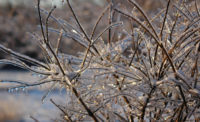From the NIOSH Director’s Desk
Working in the cold

From the National Institute for Occupational Safety and Health (NIOSH):
Depending on where you reside and work this season, Old Man Winter might be knocking on your door, bringing you snow, ice, and chilling temperatures. For those in warmer areas of the country, it may be difficult to imagine some winter weather extremes. For instance, according to the NOAA National Climate Extremes Committee, the existing record for lowest temperature in the United States was -80°F (-62.2°C) in Prospect Creek, Alaska, in 1971. Luckily, most workers will not encounter conditions quite so extreme.
Workers exposed to extreme cold or who work in cold environments may be at risk for cold-related illnesses and injuries. Susceptible workers, such as those working without shelter, outdoors, or in an area that is poorly insulated or without heat, may be put into a dangerous situation when cold weather prevails. What constitutes cold stress and its effects can vary across different areas of the country. In regions relatively unaccustomed to winter weather, even near freezing temperatures can put unaccustomed workers at risk.
Whenever temperatures drop decidedly below normal and as wind speed increases, heat can more rapidly leave the body. If workers are unable to keep warm, these cold conditions may lead to serious health problems, such as chilblains, trench foot, frostbite, and hypothermia. Hypothermia in particular, can be deadly. If a worker experiences an abnormally low body temperature, the brain is affected, making it difficult or impossible to think clearly or move well. This makes hypothermia particularly dangerous because a person may not know it is occurring and may be unable to take actions to warm themselves or seek medical care.
There are a few recommendations that employers can follow to protect workers from cold stress:
- Schedule routine maintenance and repair jobs in cold areas for warmer months.
- Schedule cold jobs for the warmer part of the day.
- Reduce the physical demands of workers.
- Use relief workers or assign extra workers for long, demanding jobs.
- Provide warm liquids to workers to consume.
- Provide warm areas for use during break periods.
- Monitor workers who are at risk of cold stress.
- Provide cold stress training that includes information on the following:
- risk factors
- prevention
- symptoms
- the importance of monitoring yourself and coworkers for symptoms
- first aid
- personal protective equipment
In addition, workers should avoid exposure to extremely cold temperatures when possible. When cold temperatures cannot be avoided, workers should follow these recommendations:
- Wear appropriate clothing.
- Wear several layers of loose clothing. Layering provides better insulation.
- Tight clothing reduces blood circulation. Warm blood needs to be circulated to the extremities. When choosing clothing, be aware that some clothing may restrict movement, resulting in a hazardous situation.
- Make sure to protect the ears, face, hands, and feet in extremely cold weather.
- Boots should be waterproof and insulated.
- Wear a hat; it will keep your whole body warmer. Hats reduce the amount of body heat that escapes from your head.
- Move into warm locations during work breaks; limit the amount of time outside on extremely cold days.
- Carry cold weather gear, such as extra socks, gloves, hats, jacket, blankets, a change of clothes, and a thermos of hot liquid.
- Include a medical and environmental thermometer and chemical hot packs in your first aid kit.
- Avoid touching cold metal surfaces with bare skin.
- Monitor your physical condition and that of your coworkers.
NIOSH also just kicked off its annual #WorkingInCold messaging on the NIOSH social media accounts. Follow along all winter for tips, tools, and resources to keep you, your employees, your coworkers, and loved ones safe while working in cold. Join the conversation using #WorkingInCold. If you don’t already, be sure to like NIOSH on Facebook and follow it on Twitter and Instagram.
Stay safe and warm this winter! For additional information on cold stress, visit NIOSH Cold Stress.
Looking for a reprint of this article?
From high-res PDFs to custom plaques, order your copy today!







